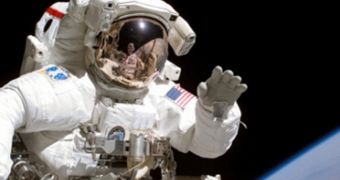The gloves that astronauts use during spacewalks are extremely difficult to operate, and they can lead to hand-related injuries. Now, experts look at new designs to improve these essential components.
At this point, in order for astronauts to survive in space, they need to wear a special pressurized suit, which also features pressurized gloves. They are very cumbersome to manipulate.
For example, space flyers that step outside of the International Space Station (ISS) to perform extra-vehicular activities (EVA) often report a condition called nail delamination.
Though it may sound harmless, it actually refers to the nail becoming loose from the nail bed, and separating completely. The most likely cause for this is operating the pressurized glove.
Additionally, astronauts have reported difficulties with grasping objects during EVA. Their sorties can at times last for up to 8 hours, and the effects on their hands are rather serious.
Scientists at the Massachusetts institute of Technology's (MIT) Department of Aeronautics and Astronautics have recently released a new statistic, showing how to avoid nail delamination.
Experts from the Department's Man Vehicle Laboratory (MVL) say that finger length may not necessarily be the main culprit. The largest fault may lie with the width of astronauts' hands.
The team studied more than 200 instances of astronaut hand injuries before arriving at this conclusion.
It was additionally shown that a significant correlation exists between the severity of the injury and the length of the metacarpophalangeal (MCP) joint, which links the palm with the fingers.
Details of the new investigation appear in a paper published in the October issue of the esteemed medical journal Aviation, Space, and Environmental Medicine.
The study was led by MIT professor of aeronautics and astronautics, and engineering systems Dava Newman, who worked with expert Roedolph Opperman and MVL statistician Alan Natapoff.
They say that limitations brought to MCP mobility are largely responsible for reducing blood flow to the fingernails, which causes the tissue damage that is responsible for delamination.
“The study points to a different cause [of delamination] and a different way to deal with it,” explains Flagsuit LLC founder Peter Homer.
His spacesuit design company is working closely with NASA on developing the next generation of space gloves. “We need to look more closely at what is going on with the MCP joint,” he argues.
Constructing the gloves is widely considered to be the most difficult part about building a space suit, industry representatives agree.

 14 DAY TRIAL //
14 DAY TRIAL //